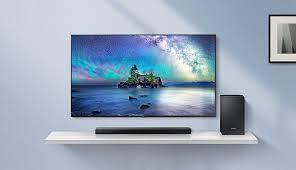With the increasing popularity of high-definition televisions, it’s no surprise that many people have purchased new TVs over the holidays. However, one aspect that often gets overlooked is the sound quality. While modern TVs offer stunning visuals, their built-in speakers often fall short when it comes to delivering immersive audio. That’s where a soundbar comes in. In this article, we will explore why adding a soundbar to your TV is essential for enhancing your home entertainment experience.
The Limitations of TV Speakers
Most TV brands prioritize picture quality and processing, often neglecting the audio aspect. As a result, even the best-looking TVs on the market tend to have mediocre sound quality. Budget-friendly options may come with low-wattage stereo speakers, while higher-end models may offer better audio but still fall short compared to a dedicated audio setup. For example, the LG C2 OLED, known for its exceptional picture quality, still can’t match the audio experience of a soundbar.
The Importance of Good Audio
Good audio is crucial for a truly immersive viewing experience. While it may not make a significant difference when watching the news, it can elevate movies, TV shows, and documentaries to new heights. A soundbar enhances audio detail, allowing you to hear subtle nuances like the creak of a floorboard, the patter of raindrops, or the underlying rumble of an explosion. These elements add depth and realism to the content on your screen, enhancing your overall enjoyment.
The Advantages of Soundbars
Soundbars offer several advantages over built-in TV speakers. Firstly, they provide a wider soundstage, allowing you to hear sound from different directions, creating a more immersive experience. Many soundbars come with multiple drivers that reproduce high, mid, and low frequencies, resulting in a more balanced and dynamic sound. Additionally, soundbars can be easily connected to your TV through HDMI or optical ports, eliminating the need for complicated setup procedures.
Different Types of Soundbars
Soundbars come in various configurations to suit different needs and preferences. Some soundbars have a 3.1.2 channel setup, meaning they have three main speakers, a subwoofer for deep bass, and two upward-firing speakers for height effects. Others offer a more comprehensive surround sound experience with a 7.1.2 channel setup, providing even more audio immersion. The number of channels refers to the number of speakers and subwoofers in the soundbar, with a higher number typically indicating better audio performance.
Flexibility and Versatility
One significant advantage of a soundbar is its flexibility and portability. Unlike built-in TV speakers, soundbars are not fixed to a specific television. You can easily move them between different screens, rooms, or even homes. This ensures that you can enjoy high-quality audio regardless of your TV setup. Moreover, many soundbars come with designated subwoofers or the ability to connect to additional speakers, allowing you to experiment with different surround sound setups.
Compatibility Considerations
When choosing a soundbar, it’s crucial to ensure compatibility with your TV’s specifications. Look for soundbars that connect through HDMI, preferably with HDMI ARC (audio return channel) or HDMI eARC (enhanced audio return channel) support. These features enable seamless communication between the TV and the soundbar, resulting in better audio quality. Additionally, if you’re interested in immersive formats like Dolby Atmos or DTS:X, make sure your soundbar supports these technologies and that your TV can pass through the respective audio signals.
Recommended Soundbars
The market offers a wide range of soundbars to suit different budgets and preferences. Here are some highly recommended options:
- Samsung HW-Q930B: This soundbar delivers immersive audio with a 7.1.4 channel setup. It offers impressive sound quality and supports Dolby Atmos and DTS:X for a truly cinematic experience.
- Sony HT-G700: With a 3.1 channel configuration, this soundbar provides excellent audio performance and features Sony’s Vertical Surround Engine technology for virtual surround sound.
- Sonos Ray: This compact soundbar offers a simple yet powerful audio solution. It delivers clear and balanced sound, making it a great choice for smaller spaces.
- Bose Smart Soundbar 600: Bose is renowned for its audio quality, and this soundbar lives up to the reputation. It features voice control, Wi-Fi connectivity, and rich, room-filling sound.
- Samsung HW-Q700B: With a 3.1.2 channel setup, this soundbar offers immersive audio and supports Dolby Atmos. It’s a great option for those looking to enhance their home theater experience.
- Samsung HW-Q990B: This soundbar boasts a 7.1.4 channel configuration and delivers powerful audio with support for Dolby Atmos and DTS:X. It’s a top-of-the-line option for audiophiles and movie enthusiasts.
Conclusion
If you’ve recently purchased a new TV, it’s essential to complement it with a soundbar to fully enjoy your home entertainment experience. The sound quality provided by a soundbar enhances the immersion and realism of movies, TV shows, and other content. With various options available to suit different budgets and preferences, you can find the perfect soundbar to elevate your audio experience. Say goodbye to lackluster TV speakers and embrace the world of immersive sound with a soundbar.


No comments! Be the first commenter?